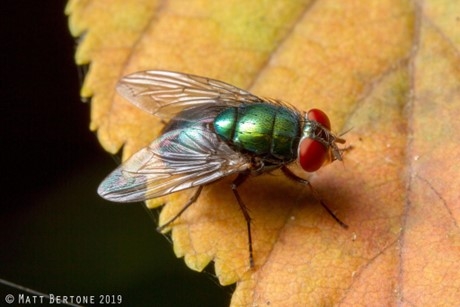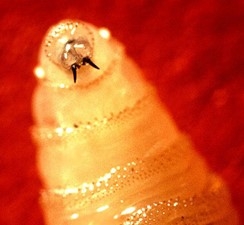Introduction
Carrion, like roadkill or half-eaten prey, serve as abundant food sources, nurseries, and even speed-dating sites for an abundance of insect pests. However, among the diversity of carrion-feeding organisms, one group stands apart: the flies. Flies are able to locate carrion from miles away to lay eggs on it, which over time hatch into larvae (maggots) that then feed on dead tissue, creating an often difficult sight (and smell) to witness. However, these maggots serve a necessary role in our ecosystems by quickly breaking down carrion that would otherwise remain a hotspot for bacteria and spread disease. Despite this benefit, the presence of carrion, and subsequent heavy populations of maggots and flies, can pose a hazard to humans when it overlaps with the built environment. Despite producing many antimicrobial molecules, flies can still spread diseases from carrion to humans. The most common type of fly associated with carrion are the blow flies (Calliphoridae, Fig. 1), easily identifiable by their blue or green iridescent sheen. In this article, we will teach you the basics of blow flies biology, the health risks they can pose, and offer recommendations for the control of unwanted blow flies in and around commercial and residential properties.
Blow Fly Biology
Most blow flies are necrophages, meaning that they eat dead animals.In fact, blow flies have an incredible sense of smell, and combined with powerful flight muscles, are able to find carrion in minutes upon emerging from pupa. In other parts of the world, many blow flies feed on living tissue and are thus parasites. However, in North Carolina, there are no blow flies that are parasites of mammals. There are about two dozen species present in North Carolina, and thousands more around the world. The most common species seen here include Lucilia coeruleiviridis (Figure 1), Cochliomyia macellaria (Figure 2), and Phormia regina. As adults, these flies can be readily identified by their metallic, usually green to blue to gray bodies. However, it can be difficult to identify maggots without training, and in fact maggots may go unnoticed until after they have pupated and emerged as adult flies.
Like other flies, blow flies are holometabolous (complete metamorphosis) and go through four life stages (egg-larva-pupa-adult) (Figure 3). Once blow flies emerge as adults they seek out carrion where they will mate and lay hundreds of eggs onto it. These eggs look like small grains of rice and are typically concentrated on open wounds or in crevices. Blow fly eggs will hatch in about 24 hours into small cream-colored larvae – known as maggots when referring to flies. These maggots are incredibly efficient feeders, using both mechanical and chemical digestion to quickly feed on carrion. These include larval “mouth hooks” used to break apart tissue as well as a large array of digestive enzymes (Figure 2). With the help of maggots, most small-bodied mammals can decompose in about a week while large-bodied mammals will take about a month, though conditions like weather can drastically affect the amount of time it takes for an animal to decompose. They are primarily interested in soft tissue like muscles and organs, so once these tissues have broken down, different insects and other arthropods will begin to feed.
After roughly one week in the larval stage, maggots pupate, and after about 8 days emerge as adult blow flies ready to repeat their life cycle (Figure 3). Depending on how long it takes a certain animal to decompose, blow flies might lay eggs on the same carrion that they just fed on as larvae. This can result in seemingly endless blow flies on carrion. Eventually, feeding material will run out, and blow flies will move on to searching for mates and new food sources. Blow flies will also feed on feces and rotting food, which is why many people see them by garbage receptacles.
Health Risks
While nature’s janitors serve a critical role, any blow fly is capable of vectoring harmful bacteria after landing on carrion, feces, and rotting food. In fact, many flies interact with septic food sources and thus carry harmful bacteria, earning them the name “filth flies”. About a third of the bacteria found on a typical blow fly are capable of causing diseases in humans, highlighting the potential risks of unmanaged blow fly populations. Blow flies transmit disease mechanically, meaning through contact-based transfer of pathogens from one source to another - a fly feeding on pet waste and then your hamburger, for example. The most common diseases or disease-causing bacteria transmitted by blow flies and closely-related filth flies are:
- Helicobacter pylori: a bacteria that attacks the stomach lining and is associated with gastritis and stomach ulcers. Some studies indicate that blow flies carry massive numbers of H. pylori bacteria and are frequent mechanical vectors.
- Escherichia coli: a bacteria that attacks the lower intestines or urinary tract and is associated with abdominal infections and sepsis. Some studies indicate that blow flies are especially effective mechanical vectors of E. coli.
- Salmonella species: a genus of bacteria that attacks the intestines and causes Salmonellosis. Some studies indicate that blow flies are especially effective vectors of Salmonella to vegetables like lettuce.
Prevention & Management
As mentioned above, most blow flies go unnoticed until large numbers of adults emerge simultaneously, often to the shock and concern of home- and business owners. These large emergences are often associated with dead and decaying animals in wall voids, crawlspaces, or even attics, and while the previously exploited food source may now be gone, this is not always the case. As such, there are several steps we recommend to help manage and prevent unwanted populations of blow flies, and to aid in their control should they suddenly appear.
Prevention
- Source Prevention & Removal. Often within built structures the presence of carrion is first noticed due to an unpleasant odor. Many times home and business owners are at a loss for how to address this indicator of a potential food source for developing blow flies. We recommend the following steps:
- Regularly inspect crawl spaces, basements, and attics for the presence of unwanted or dead animals, as animals can frequently become trapped within these spaces. If you maintain an ongoing pest management contract, discuss these types of inspections with the company, as they may include this type of service in a standard contract. If roadkill or partially-eaten animals are found close to your home or business,(or in another undesirable location), ensure its prompt removal. This can be done directly while using gloves, a shovel or similar tool, to relocate the carrion away from the property. Additionally, professional companies may offer such removal services for a fee.
- Exclusion. Flies regularly gain access to structures through both intentional and unintentional entry points. Examples of these entry points include doors and windows, opened either in transit from the exterior to the interior of the structure, to allow ventilation, or accidentally left open/ajar. To prevent entry of flies through windows be sure to install and maintain window screening throughout the year in NC. For doorways, pass through them as quickly as possible to prevent fly incursion. Additionally, products can be used that prevent fly entry (eg. air curtains) and are commonly employed in commercial settings. In outdoor environments, blow flies are abundant insects with an acute sense of smell. They will quickly find and try to feed on any food available. To prevent potential bacteria transmission onto food, keep outdoor food covered with plastic wrap or a dish. If you notice a blow fly landing on your food, be sure to remove that section of the food immediately.
- Sanitation. Blow flies will often feed on rotting food, so keeping trash bags tied tightly and ensuring your bins remain closed will prevent most flies from being able to reach a suitable food source. Further, be sure to remove waste often, changing can liners frequently. However, flies are great at sneaking into tight spaces. If you still notice fly activity in closed areas, try rinsing the garbage bins with bleach to kill remaining eggs, larvae, and pupae. Blow flies also feed on animal feces, and can rapidly lay hundreds of eggs on dog droppings. If you are a pet owner and start to notice filth flies, be sure to remove pet waste from your yard as soon as possible and throw it away in a closed bag.
Management
Ultimately, if you are faced with blow flies despite your efforts at prevention there are several management options available to you.
- Baiting & Traps. If blow flies are present in or around your built environment you can use commercial bait stations (eg. Starbar Station, EZ-Strike Station) containing granular fly bait (eg. Maxforce) which serves as an attractive and lethal food source. Scatter baits, often thrown on the ground in and around areas where flies are frequent, are another baiting solution but should not be done in areas accessible to children, pets, or livestock. These solutions require time as the fly digests the lethal bait and then dies.
In addition to baiting, several trapping options exist. Odor-baited sticky traps can be used to attract and directly catch adult flies, providing immediate removal from the environment. Light traps can also be used, and are common in commercial settings, where flies are attracted to a light source and then either trapped on glue boards or shocked. Place light-based traps along walls with an entryway to be most effective, and avoid other strong light sources in the area. It is important to note that baits and traps designed for house fly control may have varying efficacy in controlling blow flies.
- Rapid Knockdown. For additional immediate control several products exist which provide rapid knockdown on contact with adult blow flies. These include pyrethroid-based (eg. Raid Fly & Mosquito) and botanical-based (eg. Pyrid Spray) aerosols which are inhaled by the insects resulting in immediate disruption of the nervous system. Extra care should be given with these products as they are aerosolized. They should be used in well ventilated areas, and you should be careful to avoid accidental respiratory or contact exposure during and after application.
- Hire a Professional. As we discussed above, fly control is often a multi-pronged approach, with varying potential food and breeding sources, and as such can prove difficult. Professional pest management companies are trained in fly control and management, and have access to restricted-use products that may more effectively eliminate or prevent blow flies in and around your structure. If you already maintain a service contract with a pest control company, discuss options for fly management. Otherwise, research and contact a local pest management company to discuss their options for management and your unique situation.
Disclaimer: Any commercial products mentioned in this publication serve as examples only, and do not represent endorsements of the products by any entities associated with this publication.
Publication date: Oct. 14, 2024
The use of brand names in this publication does not imply endorsement by NC State University or N.C. A&T State University of the products or services named nor discrimination against similar products or services not mentioned.
N.C. Cooperative Extension prohibits discrimination and harassment regardless of age, color, disability, family and marital status, gender identity, national origin, political beliefs, race, religion, sex (including pregnancy), sexual orientation and veteran status.



